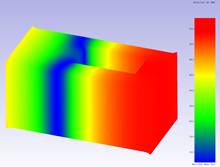A turbomachinery is an equipment involving a mechanical member (called rotor) movable in rotation and a fluid that exchange energy during the flow of the latter.
The compression turbomachinery (generator), communicating energy to the fluid (pump, fan, compressor, blower) is coupled to a motor while the expansion turbomachinery (receiver), receiving energy from the fluid (turbines e.g. gas, combustion, steam turbines) is coupled to an alternator.
Whether they belong to one or other of the above categories, whatever the thermodynamic state of the fluid (liquid or gaseous), its behavior (compressible or incompressible), and the number of stages involved in the process considered are, whether it comes to axial, centrifugal or centripetal machines, all turbomachinery have one thing in common: the noise it emits is, by nature, important (sometimes: out of norm e.g. when greater than 145 dB ref. 1pW in terms of sound power level) and it must be reduced to prevent any disorder as a result of their installation in any given location.
In some contexts, it is a question of limiting the exposure to the noise of workers e.g. the operators assigned to the conduct and the supervision of machines or to the supervision of processes, and also those in charge of the maintenance of equipment in an industrial site ; in other contexts, it is a question of preserving the environment from a noise annoyance of neighborhood: the two problems must often be taken into account for works such as power plants of production or other Establishments Classified for the Protection of the Environment (ECPE).
The acoustics of turbomachinery, in relation to the reduction of their noise emissions, therefore constitute for acousticians a subject of works (R&D, engineering, design) of choice.
In particular, the sources of noise that constitute – with respect to a a turbomachinery - the suction (i.e. the fluid inlet) and the discharge (i.e. the fluid outlet) are an opportunity for them to perform the studies, often complex, which are required in the fields of acoustics and fluid dynamics, particularly as regards the soundproofing devices commonly called "silencers".
In general, silencers for turbomachinery consist of a porous medium (such a packing must have - not at the ambient temperature at which the basic acoustic parameters are measured in a laboratory - but at the service temperature at which its properties must be extrapolated before anything else - a flow resistance sufficiently low to allow the propagation of sound waves, what is basing the dissipative effect associated with attenuation), with a perforated protection, generally multilayered (to avoid erosion due to the speed of the fluid) which constitutes absorbent assemblies installed either on the periphery of a duct (in the form of a lining ) or in the form of splitters between which the fluid flows (called baffles), whose ends are sometimes profiled with respect to aerodynamic considerations.
For the simplest soundproofing device geometries, the sizing calculations can be carried out by an analytical method e.g. with the simulation software SILDIS® (the result of a 20-year development and validation work done by the human resource of ITS), whereas for more complex geometries, the use of a method implementing a mesh is necessary.
In many cases, simulations involving CFD (Computational Fluid Dynamics) tools are useful for modeling the behavior of the fluid at the (variable) service conditions of a silencer, while computation software based on the Finite Element Method (FEM) and on the Boundary Element Method (BEM) are needed to predict the acoustic performance related to the propagation of sound in such a component of a network in which is integrated a turbomachinery.

Acoustics of turbomachinery for the reduction of their noise emissions (distribution of acoustic pressure in a silencer for frequency 63 Hz) |
Such simulation tools for acoustics and aerodynamics make it possible to carry out the appropriate calculations for the sizing of sometimes gigantic soundproofing equipment e.g. of section of the order of 100 m2 if they are those connected to the air intake or to the exhaust of large gas turbines for which the mass flow rate is rated in hundreds of kilograms per second, with - at the exhaust - temperatures commonly as high as 650 degrees C and with gas velocities greater than 100 m/s (the silencers are then integrated into exhaust systems with stacks up to 50 meters high).
The robustness of the sizing of such silencers for turbomachinery must be up to the challenges of all kinds e.g. technical, financial and legal with respect to commitments made and to obligations contracted in the context of projects for which the losses of production (e.g. in case of non-conformity of the installation when exceeding the permissible noise limit preventing its operation) can be abysmal.
ITS can be involved in the study of acoustics of turbomachinery for the reduction of their noise emissions.